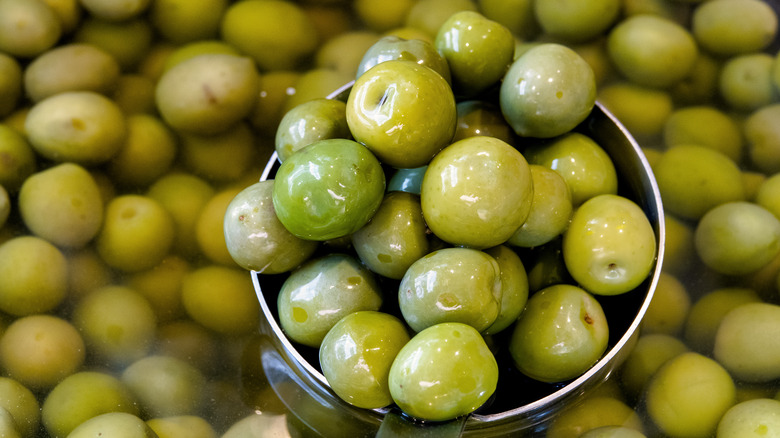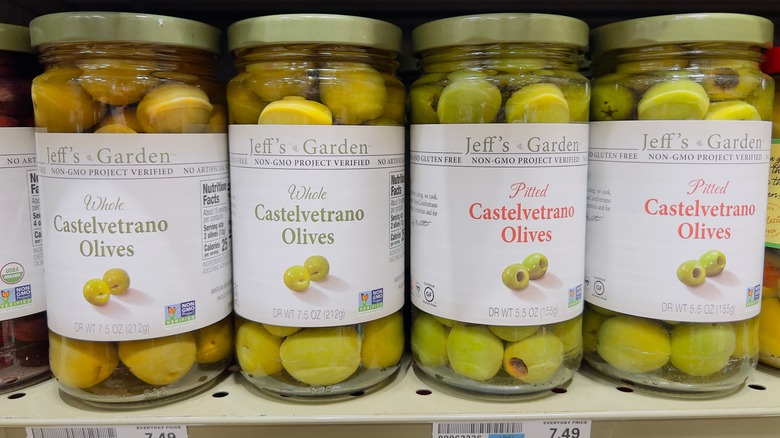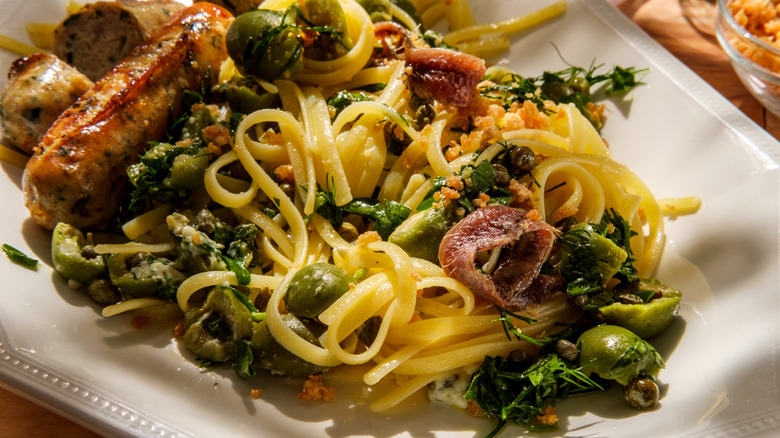New To Olives? Here's The Variety To Start With
If you're not a big olive eater, a trip to the grocery store olive bar can feel a little overwhelming. There was a time in the United States when grocery store shoppers had two choices in olives: green or black. These days, you can find all kinds of olives in different sizes, colors, and flavors, so if you're an olive newbie, it's hard to know where to start. Olives can vary pretty wildly in flavor and intensity, so it can be a bit of a gamble (and often expensive) to figure out which varieties you like.
Unfortunately, many people's first foray into olives is either the old-school style green or black olives, which aren't very flavorful, or they try a variety that has a very intense, bitter flavor, and they're turned off to olives forever. If you want to give olives a truly fair shake, point your slotted spoon toward the castelvetranos when you're at the olive bar. Olive aficionados and newbies alike widely belove these medium-sized green olives from Italy's island of Sicily for their mild but complex flavor profile. Even the most ardent olive hater should try this variety; their taste and texture will make you forget everything you thought you knew about olives.
Castelvetrano olives are for everyone
Olives are more than just the chopped-up black pieces you get on a greasy pizza or skewered on a toothpick and dropped into a martini. Much like apples, there are many different varieties of olives, also called cultivars. The International Olive Council estimates that there are at least 139 different types of olives that account for around 85% of all the olives grown worldwide, according to Olive Oil Times. In addition to different varieties, olives are also subject to different processing and packaging techniques, making a huge difference in their final flavor.
If you're new to olives and trying to arrange the perfect charcuterie board, you don't need to spend your time and money sifting through 139 different varieties to find something that makes everyone happy. Castelvetranos have a firm, meaty texture that bites almost like a fresh grape (no soggy skin like a canned black olive) and a mild, grassy, buttery flavor that is also complex. They stand on their own without being overpowering and pair well with cheese, cured meats, fresh fruit, beer, and, of course, wine. They're equally at home as an ingredient as they are a snack and work wonders in recipes like muffuletta or anything with garlic, lemon, figs, artichokes, and other Mediterranean flavors.
Where to shop for Castelvetranos
You don't have to look far for castelvetrano olives. They're readily available at most well-stocked grocery stores, both at the olive bar and often in jars in the salad dressing section. They're also gourmet enough to be sold in specialty cheese shops, as even the most discerning foodie appreciates them.
If you have a choice between pitted and unpitted olives, go for the unpitted version. Pitted olives are a little easier to work with in general, especially if you're using them in a recipe, but the flavor of non-pitted castelvetrano olives is arguably better, and they retain more of their signature texture. Think of them like stone fruits (apricots, peaches, etc.), which retain more flavor when sold whole. Also, don't stress about removing the pits because it's not that difficult; you don't need any fancy equipment to get them out, just a decent kitchen knife.
While they're a little more expensive than domestic green Manzanilla olives (the ones with the pimentos stuffed inside), castelvetranos are still easy on your wallet. You can get a decent jar of them at the grocery store for anywhere from $6-10, and it'll be totally worth spending a few extra dollars for better-tasting olives that everyone will enjoy.


